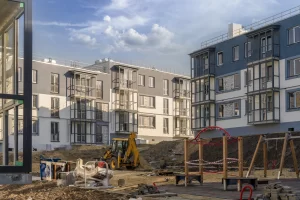Repaying your mortgage loan takes time, usually between 20 to 30 years. While it is popular in the United States to lock into 1 mortgage for the full term, in Canada it is far more frequent to break this repayment period into smaller terms, usually 1-5 years. At the end of your term, you have the option to either:
- Pay off the remaining mortgage in full with no penalty. (Lucky you!)
- Renew your mortgage for a new term with your current lender
- Shop around the market to find a new mortgage product
OSFI anticipates 76% of all outstanding mortgage terms will mature by the end of 2026 [1] and many of these mortgages will be renewing into an interest rate environment that is much higher than when their current mortgages began. For example:
In 2020, a homebuyer secured a mortgage principal of $450,000, on a 5-year fixed rate of 1.89% amortized over 25 years. They’ve been making payments of $1,881.73. Over 5 years, assuming no pre-payment privileges were used, they will have a remaining principal balance of $377,378.25.
Upon their maturity, they might be offered the following:
- Starting Principal: $377,378
- Interest Rate: 4.75%
- Amortization: 20 Years
- Term: 5 Year Fixed
- Monthly Mortgage Payment: $2.429.17
This would increase their monthly mortgage payment of $547.44. A fairly significant increase to a potentially tight budget.
What are the Options for Renewing Your Mortgage?
Regarding affordability, there are a few potential options that this person has at renewal, mostly based on adjusting the amortization:
- Keep the repayment schedule on track (20 Years)
- Extend amortization to 25 years (keep insurable mortgage rate)
- Refinance amortization to 30 years (Conventional mortgage, highest interest rate)
Assuming these are all 5-year terms, here is a summary of what these mortgages will look like after 5 years:
| 20 Year | 25 Year | 30 Year | |
| Monthly Payment |
$2,429.17 |
$2,192.70 |
$2,116.54 |
| Interest Rate |
4.75% |
4.99% |
5.45% |
| Remaining Amortization |
15 Years |
20 Years |
25 Years |
|
Total Principal Paid |
$64,116.20 | $43,422.48 |
$28,968.54 |
|
Total Interest Paid |
$81,116.40 | $88,139.52 |
$98,023.86 |
|
Total Payments |
$145,750.20 | $131,562.00 |
$126,992.40 |
| Remaining Principal |
$313,261.85 |
$333,955.77 |
$348,409.71 |
As you’ll see, you can reduce your mortgage payment by a few $100 if you’re in a pinch by refinancing your amortization. However, it may not be the best move for your long-term financial health.
- You will owe more at the end of your term than if you stick to the same repayment schedule.
- You will pay more interest over 5 years. Uninsurable loans (with amortizations greater than 25 years tend to carry higher interest rates)
- You will be back to where you started regarding amortization (with a smaller principal).
Steps You Can Take To Stay On Track
No two mortgage files are the same, and these figures are just general forecasts. But, there are some steps I encourage all borrowers to follow at this time.
- See what your current renewal options are as soon as possible, these are usually issued 1-3 months prior to your renewal date.
- Consult with your mortgage advisor 6 months prior to your renewal to see where you stand and get a feel for the market rates. You can keep your amortization schedule on track and move to a different lender through a transfer/switch.
- Review your monthly budget and account for your higher payment ahead of time. If your monthly cash flow is tight or negative, some restructuring may be needed.
These are uncertain times, but with proper planning and execution, we can all power through. If you have a renewal coming in the next 2 years, a no-cost consultation with a trained mortgage professional is a great place to start. Book here today!
[1] https://www.osfi-bsif.gc.ca/en/about-osfi/reports-publications/osfis-annual-risk-outlook-fiscal-year-2024-2025






